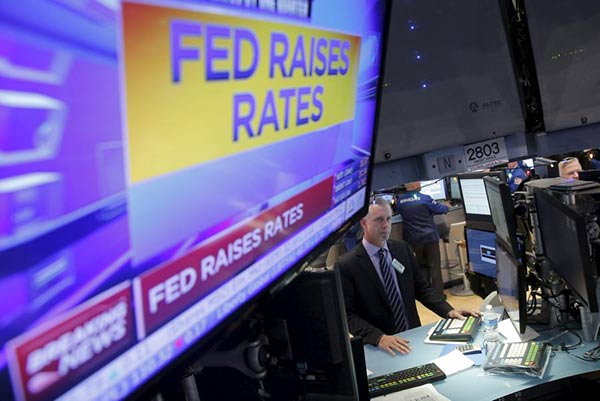The perils of Fed gradual normalization
Updated: 2016-01-27 08:00
By Stephen S. Roach(China Daily)
|
||||||||
 |
|
Traders work on the floor of the New York Stock Exchange (NYSE) shortly after the announcement that the US Federal Reserve had hiked interest rates for the first time in nearly a decade in New York, Dec 16, 2015. [Photo/Agencies] |
By now, it's an all-too-familiar drill. After an extended period of extraordinary monetary accommodation, the US Federal Reserve has begun the long march back to normalization. It has now taken the first step toward returning its benchmark policy interest rate - the federal funds rate - to a level that imparts neither stimulus nor restraint to the US economy.
A majority of financial market participants applaud this strategy. In fact, it is a dangerous mistake. The Fed is borrowing a page from the script of its last normalization campaign - the incremental rate hikes of 2004-2006 that followed the extraordinary accommodation of 2001-2003. Just as that earlier gradualism set the stage for a devastating financial crisis and a horrific recession in 2008-2009, there is mounting risk of yet another accident on what promises to be an even longer road to normalization.
The problem arises because the Fed, like other major central banks, has now become a creature of financial markets rather than a steward of the real economy. This transformation has been under way since the late 1980s, when monetary discipline broke the back of inflation and the Fed was faced with new challenges.
The Fed had, in effect, become beholden to the monster it had created. The corollary was that it had also become steadfast in protecting the financial-market-based underpinnings of the US economy.
Over time, the Fed's dilemma has become increasingly intractable. The crisis and recession of 2008-2009 was far worse than its predecessors, and the aftershocks were far more wrenching. Yet, because the US central bank had repeatedly upped the ante in providing support to the Asset Economy, taking its policy rate to zero, it had run out of traditional ammunition.
- Global health entering new era: WHO chief
- Brazil's planning minister steps aside after recordings revelation
- Vietnam, US adopt joint statement on advancing comprehensive partnership
- European border closures 'inhumane': UN refugee agency
- Japan's foreign minister calls A-bombings extremely regrettable
- Fukushima impact unprecedented for oceans: US expert

 Stars of Lijiang River: Elderly brothers with white beards
Stars of Lijiang River: Elderly brothers with white beards
 Wealthy Chinese children paying money to learn British manners
Wealthy Chinese children paying money to learn British manners
 Military-style wedding: Fighter jets, grooms in dashing uniforms
Military-style wedding: Fighter jets, grooms in dashing uniforms
 Striking photos around the world: May 16 - May 22
Striking photos around the world: May 16 - May 22
 Robots help elderly in nursing home in east China
Robots help elderly in nursing home in east China
 Hanging in the air: Chongqing holds rescue drill
Hanging in the air: Chongqing holds rescue drill
 2.1-ton tofu finishes in two hours in central China
2.1-ton tofu finishes in two hours in central China
 Six things you may not know about Grain Buds
Six things you may not know about Grain Buds
Most Viewed
Editor's Picks

|

|

|

|

|

|
Today's Top News
Liang avoids jail in shooting death
China's finance minister addresses ratings downgrade
Duke alumni visit Chinese Embassy
Marriott unlikely to top Anbang offer for Starwood: Observers
Chinese biopharma debuts on Nasdaq
What ends Jeb Bush's White House hopes
Investigation for Nicolas's campaign
Will US-ASEAN meeting be good for region?
US Weekly

|

|









